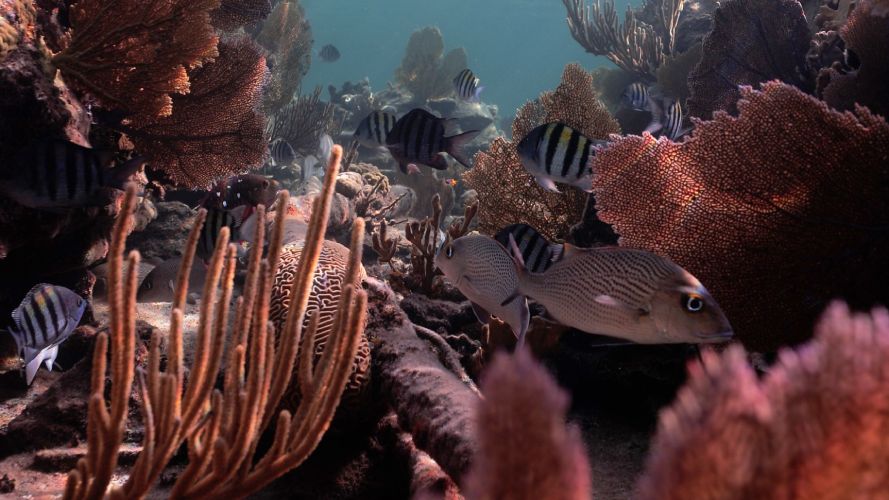(APRIL 17, 2020) NASSAU, BAHAMAS- In November 2019, when it was first documented in The Bahamas, Stony Coral Tissue Loss Disease (SCTLD) – a newly emergent marine epidemic with no cure- has rapidly spread in five months over 20 percent of coral reefs in Grand Bahama’s National Parks. The national parks that are affected include Peterson Cay National Park and Lucayan National Park. The results of a rapid assessment, completed in March 2020 by Perry Institute of Marine Science (PIMS), leaves park wardens and environmental stewards deeply troubled.
“Corals found throughout The Bahamas are the building blocks of reef ecosystems. We have known for decades that coral reefs face many threats such as natural predators, climatic changes and human interference, but this recent discovery of a deadly coral disease in our national parks is the gravest threat to corals in Grand Bahama and throughout the archipelago,” explained Lakeshia Anderson, Parks Director, Bahamas National Trust

Aerial of Mature Coral Reef Colonies | Grand Bahama’s National Parks
Healthy corals support countries like The Bahamas by providing incredible marine biodiversity including nursery grounds for economically important fisheries, protecting coastal communities from storm surges, increasing gross domestic product through fisheries and tourism. These important systems are simply the foundation of marine life.
The emergence of a new coral disease appeared off the coast of South Florida in 2014. At a rapid growth rate it did not take long for SCTLD to decimate mature coral species from West Palm Beach to Key West, Florida. To date more than ten million dollars have been spent trying to understand this epidemic. Despite this, marine biologists and scientific institutions have not yet identified the disease’s pathogen and as such are still scrambling to find a science-based conservation strategy to combat it.

Example of Healthy Corals and Marine Life in National Parks
Having spread to neighbouring Caribbean nations, SCTLD was first detected in The Bahamas in 2019. It has now been confirmed to have infected some of the reef building corals off the coast of Grand Bahama, including reefs within the Peterson Cay National Park as well as Lucayan National Park. The epicenter of the disease locally is less than 40 miles away, near Freeport.
Shelley Cant-Woodside, Director of Science, Bahamas National Trust, said: “The high rate of infection and mortality of SCTLD will be a catastrophic loss to coral ecosystems in The Bahamas. If it continues at its present rate, this disease has the potential to kill more than 50% of all coral species found in Bahamian waters. Even our most robust colonies that have taken centuries to grow could be wiped out in a very short period of time.”

SCTLD-infected Grand Bahama corals | studied by Perry Institute of Marine Science
With somber realities propelling its commitment to protect the country’s national parks, even in times of global crisis, The BNT is working closely with experts from The Bahamas Government, the scientific community, and other strategic partners such as PIMS, The Nature Conservancy, and B.R.E.E.F.
The Minister of Agriculture and Marine Resources, The Honourable Michael Pintard, has been briefed by his technical team from the Department of Marine Resources and he has taken this matter to Cabinet. Collective recommendations were set forth that the Minister establish a special task force to include relevant government agencies and partners, including representatives from the National Fisheries Association of The Bahamas. That task force would have, as a priority, to develop a response plan.
For the BNT, there is an urgency to establish early detection of the disease throughout Bahamian national parks and to work with experts to determine if implemented measures indeed slow down its spread.
This disease underscores the importance of having national parks and marine protected areas. These nature reserves act as a refuge- where ecosystems are healthier and less stressed. Although SCTLD has been spotted within two national parks and is affecting various coral species, the outcome may be better in these managed spaces where monitoring and disease impact can take place undisturbed. National parks protect healthy coral reefs from Grand Bahama to Inagua. As such they offer the best opportunity to successfully apply science-based strategies and conservation measures to combat the disease. This will help protect the biodiversity of vibrant oceans that are essential to our Bahamian way of life.
References:
https://sanctuaries.noaa.gov/news/aug18/coral-disease-mystery-florida-keys.html
https://oceanservice.noaa.gov/education/kits/corals/coral04_reefs.html
https://desmioceanguard.com/UserFiles/file/OxyClean_2014.pdf
About:
The Bahamas National Trust (BNT) was created by an Act of Parliament in 1959 to build and manage the national park system of The Bahamas. Possibly the only non-governmental organization in the world charged with such a responsibility, the BNT works daily to conserve and protect the natural resources of The Bahamas through stewardship and education for present and future generations. There are currently 32 National Parks managed by the BNT with more than 2 million acres of marine and terrestrial areas protected.
Media Contact:
Anna Bancroft, Communications Manager, Bahamas National Trust
Cell. 242-424-1764 / Tel. 242-393-1317
Email: abancroft@bnt.bs